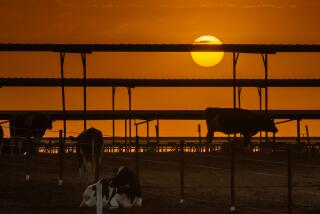Searching High for Signs of Altitude Sickness
- Share via
LARAMIE, Wyo. — The patients lingered behind the wooden fence, eyes downcast, chests heaving. If they could, they’d be wearing oxygen masks.
“Their hearts are the size of volleyballs,” said Mark Stayton, a professor of microbiology at the University of Wyoming. “They should be the size of softballs.”
Stayton and colleague Rich McCormick are on the cutting edge of research into altitude sickness -- in cows.
Once they get 5,000 feet above sea level, some cattle get woozy from the thin air. Fluid collects in their hearts and lungs. Listlessness sets in. Death follows. The symptoms are similar to those seen in people suffering from emphysema, where every breath is a struggle.
The scientists are taking blood samples from sick cows and compiling a database, looking for a genetic marker that might indicate which animals are prone to altitude sickness. That way, animals could be identified before being brought to ranches in the Rocky Mountain West, where the problem is most severe.
“The ability to predict what animals are predisposed to this ... would be invaluable,” McCormick said.
The University of Wyoming is perfectly suited for such experiments. It’s at an elevation of about 7,100 feet, and maintains a working cattle ranch.
Young cows suffering from the ailment stand in muddy pens beside healthy animals. The sick ones have swollen necks; they weigh about one-third less than they should.
“What’s happening is that it’s hard for these cows to force blood through their lungs,” McCormick said. “They have a lot of stress, their hearts enlarge and they begin to do poorly.”
Stayton bent down and looked closely at the ill cattle. Many were likely to die of congestive heart failure unless they were moved to a lower altitude.
“If we found a genetic fingerprint that could identify which animals would develop this, the ultimate goal would be to try and breed the tendency out of them,” Stayton said.
As physically distressing as altitude sickness is for the cows, it’s financially painful for ranchers. On average, according to researchers, between 3% and 10% of calves in areas above 5,000 feet die each year because of altitude sickness -- also called brisket by ranchers. In extreme cases, 20% of a herd can be lost.
Cattle ranches in Colorado and Wyoming are hit hardest because so many pastures sit at high elevations. Sometimes animals are brought up from lower locales and get sick; other times they are born susceptible to the condition.
“If we are bringing in new blood, there is a risk. We once had 11 calves and lost nine of them to brisket,” said Gary Parker, a rancher in Laramie. “I have known folks who lost 65 head. The average steer price is $700, so that is a serious economic impact.”
Mike Shields, who raises cows in Westcliffe, Colo., said ranchers in flatter parts of the country often had no idea the problem existed.
“I worked in Nebraska, and they didn’t know anything about it,” said Shields, whose ranch sits at 8,500 feet. “But a cow from Louisiana or Texas just won’t make it up here.”
The prevalence of the illness makes Western cattlemen careful about which animals they buy. Bulls that test positive for brisket are hard, if not impossible, to sell. That’s because they probably will pass the illness to their offspring.
Many ranchers depend on Tim Holt, one of a handful of veterinarians who travel the West testing cows for brisket.
Over the last 20 years, Holt has done 137,400 tests and is collaborating with Stayton and McCormick on their research.
His technique is not for the squeamish. Cows are placed in a chute, their heads are turned sideways and a large needle is inserted into the jugular vein. A catheter is threaded through the pulmonary artery and the pressure is taken. If the animal is sick, it will have trouble pumping blood to its lungs, and pressure will be high.
“Cattle are genetically prone to pulmonary hypertension and heart failure,” said Holt, an assistant professor in the School of Veterinary Medicine at Colorado State University. “It’s not uncommon for a rancher to lose 3% of his herd ... which is totally unacceptable.”
Animals that pass the test are given certificates. A prize bull can sell for $5,000, but if that same animal failed its physical, a seller would be lucky to get $1,000.
Holt wants to find a less invasive way to diagnose sick animals, and he’s confident they carry a DNA marker for the illness.
“We know there is a gene for high-altitude disease; we just haven’t isolated it yet,” he said.
Stayton believes that because cows and humans have so much in common physiologically, the research could benefit people.
“I think this could have applications in certain humans,” he said. “We just don’t know to what extent right now.”
More to Read
Sign up for Essential California
The most important California stories and recommendations in your inbox every morning.
You may occasionally receive promotional content from the Los Angeles Times.










